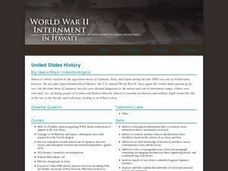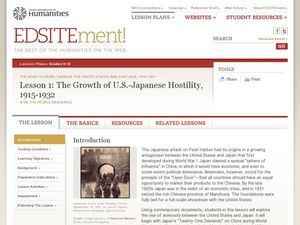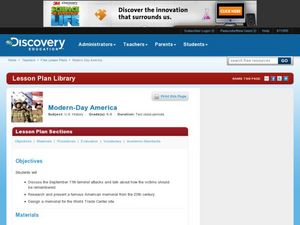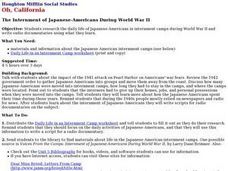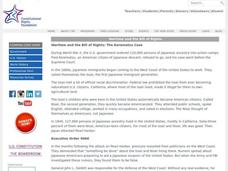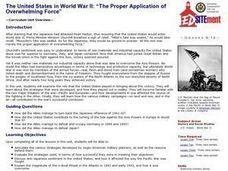Curated OER
World War II: Internment in Hawaii
Learners examine world history by writing an essay in class. In this World War II lesson plan, students identify the attack on Pearl Harbor, the response from the U.S and the effect it had on Japanese-Americans. Learners define Japanese...
Curated OER
The Growth of U.S.-Japanese Hostility, 1915-1932
Learners explore the relationship between Japan and the United States between 1915 and 1932. In this diplomacy lesson, students examine the Open Door Policy, 21 Demands, and the invasion of Manchuria by Japan. Learners conduct research...
Curated OER
Modern-Day America
Students remember the September 11 terrorist attacks. In this public memorials lesson, students research 20th century memorials. Students then design their own memorials for the victims at the World Trade Center site.
Curated OER
Local Mobilization for War
Tenth graders analyze how government policies led to complete concentration in war effort, evaluate how patriotism was encouraged by many local and state groups, and discuss fate of Japanese Americans.
Curated OER
Pacific War Timeline
Students visit the George Bush Gallery of the Pacific War where they complete a timeline of important events. Prior to the visit, they create a blank timeline from 1937 to 1945 and fill in events discovered at the museum. After the...
Curated OER
The Internment of Japanese-Americans During World War II
Eleventh graders research the daily life of Japanese-Americans in internment camps during World War II and write radio documentaries using what they learn.
Curated OER
"Martial Law in Hawaii After the Attack on Pearl Harbor"
Students explore the concepts of martial law, writ of habeas corpus, due process, discovery and human and constitutional rights during World War II. They assess the roles and responsibilities of government leaders and citizens during...
Curated OER
Wartime and the Bill of Rights: The Korematsu Case
Learners examine the balance between civil liberties and protection. In this national security lesson, students explore the Korematsu case which references the Japanese internment camps of World War II. Learners draw comparisons between...
Curated OER
Wartime and the Bill of Rights: The Korematsu Case
Twelfth graders work together in groups to examine the discrimation Japanese Americans felt after the bombing of Pearl Harbor. Using primary source documents, they analyze and discuss the case of Fred Korematsu who was placed in an...
Curated OER
Attack on Hiroshima and Nagasaki
Sixth graders hear a story about the atomic bombing of Japan and write an editorial about the event from the perspective of either a Japanese or an American.
Curated OER
Wartime and the Bill of Rights: The Korematsu Case (Lesson 2)
Twelfth graders review how the government and Bill of Rights came into effect. Using primary source documents, they discuss if Japanese rights were violated when they were placed in internment camps after the bombing of Pearl Harbor. ...
Curated OER
Defining Moments-from the past with lessons for a post 9/11 world
Students use the spreadsheet to determine policy options, establish criteria for the solution, weight the criteria in terms of importance and rate the options relative to each criterion to determine a solution to the problem. They...
Curated OER
Vietnam War: Kennedy Assassination
Students determine how the Kennedy assassination impacted the United States and, more specifically, the Vietnam War. In this 20th century American history lesson plan, students read books and view video clips of the event and then write...
Curated OER
Why do wars occur?
Understanding the causes of war is one way (possibly) to prevent it. World War II is used as a case study to facilitate an understanding of reasons why wars start. Topics covered included Totalitarianism, scarcity of resources, need for...
Curated OER
Dr. Seuss Takes on Charles Lindbergh
Students study the leaders of the isolationist movement within the United States and the causes of the isolationist movement, they recognize and compare the perceptions of both the isolationists within the US and those who took a more...
School Improvement in Maryland
Executive Order
After reading information about Executive Order #9066, class members assume the voice of an 18 year-old Japanese-American born in California and placed in an internment camp. Individuals then craft a letter to President Roosevelt...
Curated OER
"The Proper Application of Overwhelming Force": The United States in World War II
Students examine the role that the U.S. played in bringing about victory in the two major theaters of the war in the Pacific and Europe. How the various military campaigns contributed to the war's successful conclusion forms the focus of...
Curated OER
Turning the Tide in the Pacific, 1941-1943
Students explore the overall strategies pursued by the Japanese and the Allies in the initial months of World War II. What each side hoped to accomplish what what actually happened forms the basis of a comparison made in this activity.
Curated OER
Turning the Tide in Europe, 1942-1944
Students explore the overall strategies pursued by the Americans and their British allies in the initial months of World War II in Europe. By examining military documents, students examine the decision to invade North Africa instead of...
National Endowment for the Humanities
How to Win a World War
High schoolers are have begun to learn the art of diplomacy with each other, but do they understand how diplomacy works at a global level? The second in a series of four lessons, guides scholars in evaluating primary sources. The why...
Constitutional Rights Foundation
The Cold War: How Did It Start? How Did It End?
What is the difference between a Cold War and a Hot War? Scholars research the beginning of the Cold War. They analyze diary entries as well as excerpts from various events during the 45-year standoff. To finish, they prepare final...
Curated OER
WWII German Submarine Warfare: U505
Young scholars research how the capture of a German submarine by the Allies affected the outcome of WWII. In this WWII lesson, students complete a KWL chart. Young scholars research primary source documents online and answer discussion...
Scholastic
The Rise of Railroads: California
Railways are an integral part of the history of California. Using a timeline format, class members connect major historical events to the rise of the railroads and their impact on the state. Activities include a mix of independent and...
Scholastic
The Rise of Railroads: Illinois
Railways not only cross the US, but they are also intertwined with the history of America. Using a timeline format, individuals explore the connections between major events in American history—such as the Civil War—and the rise of the...


